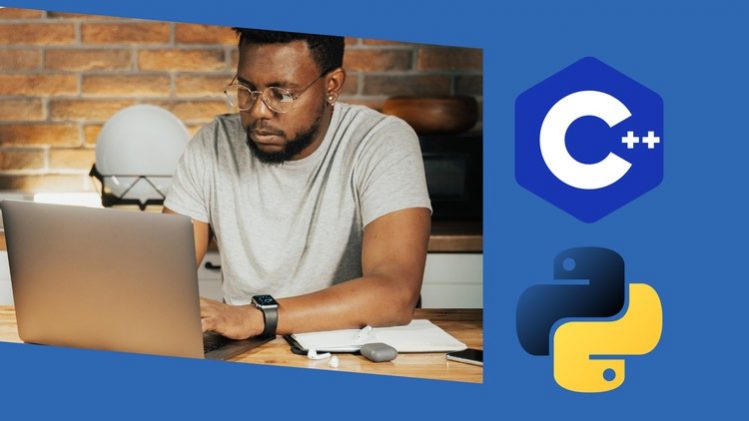
Introduction to C++ And Python Programming and general Understanding
Practical demonstrations of C++ Programming And Python Programming
Learn about C++ And Python programming the software’s interface
Learn C++ Arrays, C++ Operators C++ Assignment, Logical, Relational Operators
C++ Accessing Structure Members,C++ Functions,Calling a Function, Class Template,Conditional Compilations
Learn Python Arrays, Python Operators, Arithmetic, Bitwise, Membership Operators
Python List, Python Access, Update And Delete Lists, List Methods, Built-in functions
Python Tuple And Tuple Operations, Python Dictionary And Dictionary Operations
Python Conditional Statements, Python Loops and Statements
Python Functions, Python Trigonometric and Inverse Functions
C++ And Python Programming Complete Course
Why This Course:
- 12 hours of Applied Learning
- Hands-on coding and implementation of each tutorial
- Lifetime access to self-paced learning
- Flexibility to choose careers in C++, Java.And Python And PHP
Section 1- C++ Complete Course
This course is an introduction to the C++ programming language and its subset, the C++ programming language. Program structure, block, storage types, console and file I/O, functions, arrays, strings, pointers, call-by-reference, call-by-value, and dynamic memory allocation will be discussed. The concept and use of classes will be covered in some detail. The differences between C++ will also be discussed.
Course Rationale: This course is designed to teach students the C++ programming language and introductory and intermediate programming concepts with examples and applications using the C++ language. The course builds and extends topics covered in the prerequisite course, COSC 1315 and prepares students for more advanced programming courses such as ITSE 2431 (Advanced C++ Programming) and COSC 2415 (Data Structures) as well as for entry level programming employment. The course is required for an Associate Degree in several Computer Information Systems and Computer Science degree areas.
STUDENT LEARNING OUTCOMES/LEARNING OBJECTIVES
Course Objectives/Learning Outcomes:
- Demonstrate a thorough understanding of modular programming by designing programs that require the use of programmer-defined functions.
- Demonstrate a thorough understanding of arrays by designing and implementing programs that search and sort arrays.
- Demonstrate a thorough understanding of the object-oriented programming concepts of encapsulation, data abstraction and composition by designing and implementing classes including the use of overloaded functions and constructors.
- Demonstrate a thorough understanding of the concept of pointers and dynamic memory allocation by designing and implementing programs using pointers and dynamic memory allocation.
- Demonstrate a thorough understanding of the implementation of programmer-defined functions and classes by writing code, performing unit testing and debugging of multiple complex programs.
- Demonstrate good documentation style in all of the programs written in this course.
- Demonstrate proficiency in implementing data validation code, performing unit testing, and developing test plans while implementing robust solutions to the assignments in this course.
- Demonstrate a thorough understanding of stream input/output for both console and files.
- Demonstrate an understanding of the differences between C++ in the areas of strings, pass by reference/passing pointers, and structs by designing and implementing programs that use C++ strings, C++ language structs and classes.
- Learn in this Course
- To learn the fundamental programming concepts and methodologies which are essential to building good C++ programs.
- To practice the fundamental programming methodologies in the C++ programming language via laboratory experiences. …
- To code, document, test, and implement a well-structured, robust computer program using the /C++ programming language.
- Section 2 – python programming language.
Python is a language with a simple syntax, and a powerful set of libraries. It is an interpreted language, with a rich programming environment, including a robust debugger and profiler. While it is easy for beginners to learn, it is widely used in many scientific areas for data exploration. This course section provides an introduction to programming and the python language. students are introduced to core python programming concepts like conditionals, loops, variables, and functions. this section includes an overview of the various python aspects. It also provides hands-on coding exercises using commonly used writing custom functions, and reading and writing to files. this section or whole course may be more robust than some other courses, as it delves deeper into certain essential programming topics.
what you will learn in this section:
- Identify core aspects of programming and features of the Python language
- Understand and apply core programming concepts like conditionals, loops, variables, and functions
- Use different ways for writing and running Python code
- Design and write fully-functional Python programs using commonly used data structures, custom functions, and reading and writing to files
- and more..
Thank you and see you inside the course.






